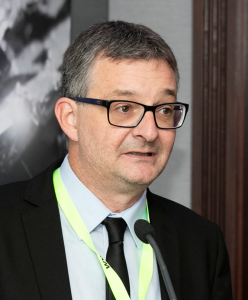
Dirk Nelen holds a MSc in Bioscience Engineering. He has extensive experience of working as an environmental consultant in South America, and later on involvement in numerous nationally and EU funded projects and studies for policy support in the area of sustainable materials management as a senior researcher at the Flemish Institute for Technological Research VITO. Dirk now leads the VERAM project work package that will define and explore the European raw materials playing field.
1. What did VERAM expect to learn from the exploration of the European raw materials field?
Increasing awareness of the essential role of raw materials in responding to future societal challenges has become evident in the development of national and sectoral strategies and policies, industry roadmaps and national and EU-wide strategic research agendas, that all acknowledge the relevance of securing sustainable raw materials supply.
We were convinced that VERAM partners, representing both European Technology Platforms with raw material-intensive industries, as well as research and innovation communities, would be well-placed to recognize the different needs of European industries and global markets. When these needs are then set against ongoing research activities and research funding on European and national level, we expect to be able to identify gaps in the research and innovation landscape.
2. What is the role of VERAM in dealing with these identified gaps?
The VERAM project partners, together with engaged stakeholders from the raw materials sector, are developing a bold vision of how they want their sector to contribute to resolve the future challenges in the domains of energy, construction, mobility and communication, and other areas with an important materials component. The next step, that is still ongoing, consists in building a roadmap for developing the research and innovation that are expected to be required to realize the vision. Of course, this roadmap will not start from scratch, but instead should converge the different existing agendas and roadmaps and at the same time fill the identified gaps they might have.
3. But how can we know what gaps will be relevant in the future?
This is why we built different future scenarios. Scenarios are a tool for analysing plausible futures. We have then analysed the opportunities and threats for the European raw materials sector under each of the scenarios. Prioritization of research and innovation actions that are specific to each scenario should help to benefit from the opportunities, while minimizing the effects of the threats. On the other hand, this work package compiled an extensive inventory of relevant raw materials stakeholders, often fragmented policies, funding programmes and research agendas, that allows to infer a general orientation of future research and innovation efforts.
4. What are the next steps to be undertaken in the research and innovation gap analysis?
To complete the ongoing gap analysis, VERAM partner researchers and experts have assessed the relevance of a wide array of research and innovation actions and of key enabling technologies innovation fields, under each of the future scenarios, and for different material-intensive industrial sectors. We are now processing the obtained data by making use of a scientific methodology: Multiple Correspondence Analysis. As a result, we will obtain a set of visuals that allow an intuitive interpretation of the particular research actions and innovation fields that in the future will be essential or important to develop, in each plausible scenario. If it is observed that the earlier identified ongoing and proposed research actions fall short in a particular area, we definitely would consider reinforcing these areas in the VERAM roadmap!
5. Can you share some unexpected insights from your work so far?
To me, it was surprising to discover that the EU forestry product dependent sectors can rely considerably more on domestic resources for the building up of their product value chains compared to those sectors that rely on raw materials from mining and quarrying that, unfortunately, must import a relevant share of the raw materials required to realize their final output. We found many similarities between forest-based materials sectors and minerals and metals sectors regarding their respective research needs. The different import dependencies, however, will probably make the raw material policies designed for each of the two sectors to have to face different challenges, while holding other opportunities.